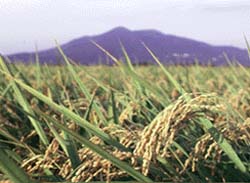
Members of the international consortium from China, US, Japan, France, etc.

A detailed analysis of the high-quality sequence of the rice genome was published in the August 11 issue of the journal
Nature, marking the completion of a six-year international collaborative effort to unravel the genome of the world's most important food crop that feeds over half of the global population.
The work unveils a genome consisting of roughly 400 million DNA bases holding 37,544 genes on rice's 12 chromosomes, affirm scientists in the
Nature article, offering an overview of the structure and function of the genes that defines the rice plant, and providing clues on how the sequence can be useful to accelerate the improvement of the plant.
The sequencing was accomplished by the International Rice Genome Sequencing Project (IRGSP), a consortium of publicly funded laboratories from nine countries. Two groups of Chinese researchers led by the CAS National Center for Gene Research (NCGR) in Shanghai and the Academic Sinica Plant Genome Center in Taiwan finished the sequencing of chromosomes 4 and 5, respectively. CAS researchers also fulfilled comparative genomics between Nipponbare (
Oryza Sativa japonica Oryza sativa subsp. japonica cv.Nipponbare) and rice cultivar 93-11 (
Oryza sativa L. ssp. indica) and the analysis of a sequenced centromere.
The sequencing work is the result of effective and full cooperation among scientists both at home and abroad, says Dr. Han Bin, NCGR director. Originally planned as a 10-year project, the sequence was completed four years ahead of schedule thanks to the close collaboration. Through the project, Chinese researchers not only increase their international presence in the field but also benefit a lot in from information, technology and resources sharing, and talent training.
This is one of the most accurate and complete sequences from a higher organism, according to experts. The accuracy of the sequence data is maintained at 99.999% corresponding to less than one error per 10,000 bases so that the reliability of identified genes is also high. Previously published draft sequences of rice are shown to lack the coverage and accuracy required to identify important genes.
The accurate, map based sequence has already led to the identification of genes responsible for agronomically important traits such as genes that affect growth habit to promote yield and photoperiod genes to extend the range of elite cultivars, says scientists. This could probably provide the key in improving yield to feed an expanding world population at a time of increasing restraints on agriculture.
Researchers say that the genetic information of rice will also be useful in understanding the genome of other crops in the grass family including corn, wheat, barley, rye and sorghum, all of which share a common ancestor with rice.






